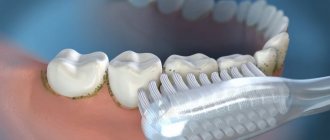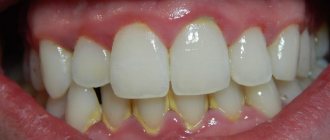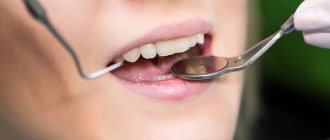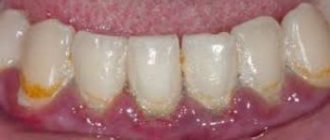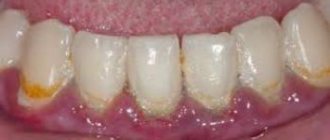Why plaque and stone are dangerous
The plaque that settles on the teeth is soft. It can be easily removed with any hygiene products. Within 6-12 hours it reacts with the components of saliva, becomes saturated with calcium salts and hardens. The only way to prevent this is to use mouthwash throughout the day. Once the plaque has hardened, it can no longer be removed.
Tartar gradually forms. It continues to grow as new layers of plaque easily “stick” to the rough surface. After about 6 months it becomes visually noticeable, but this is not its main danger.
The stone grows in the cervical part of the crown, gradually penetrating into the subgingival area. This leads to mechanical damage to the gums and loosening of the teeth. Microorganisms cause gum inflammation and provoke more severe oral diseases. Patients complain of bleeding and sensitivity of the gums, and bad breath. With further growth of the stone deeper into the gums, there is a risk of developing cysts on the root of the tooth.
Cleaning teeth from stone: techniques and their effectiveness
Table of contents
- Causes of tartar formation
- Methods for removing tartar
- Stone removal technique
- Cost of teeth cleaning
- Advantages of carrying out the procedure at MEDSI
We offer all patients of the MEDSI clinic a dental tartar cleaning
.
The procedure is carried out by dentists at least once every six months
and helps
prevent the development of caries and dangerous gum pathologies
, ensure fresh breath, relieve the patient of complexes and achieve overall oral health.
Teeth cleaning from tartar is carried out in MEDSI clinics using modern safe and highly effective methods to avoid tissue injury. During a fairly simple procedure, which usually lasts no more than 40-60 minutes, patients, even with a low pain threshold and high sensitivity, do not experience significant pain or discomfort. Thanks to this, cleaning can be carried out in almost all cases.
Causes of tartar formation
In the oral cavity of each of us, 200 billion different bacteria and other microorganisms are concentrated. At the same time, not all people devote enough time and effort to hygiene. Often it is not carried out very well and not as often as required. Few people use a toothbrush or even just rinse their mouth after breakfast, lunch and dinner to remove food debris. As a result, bacteria actively multiply and settle on soft and hard tissues, in gum pockets and in the spaces between elements of the dentition.
At first, the deposits remain soft, they can still be removed at home by regularly practicing hygiene. If soft deposits are not removed in a timely manner, they will harden and turn into dense stone. It is almost impossible to get rid of it
.
It is the stone (hard plaque) that causes:
- Bad breath
- Pigmentation of the enamel (its partial or complete darkening), worsening the appearance of the oral cavity and provoking a number of complexes in a person
- Development of caries
- The occurrence of pathological processes even in the gastrointestinal tract
Important! Tartar can appear even in those people who do not neglect hygiene, regularly brush their teeth and use special floss (dental floss) or irrigators. This is due to the fact that it is almost impossible to clean narrow spaces and gum pockets efficiently.
There are certain categories of foods and drinks that provoke a fairly rapid and intense formation of dense plaque, and then stone. These include coffee and wine, as well as sweets, pastries, and other delicacies. No one is protected from the occurrence of unpleasant plaque and tartar.
For this reason, we recommend regular teeth cleaning at MEDSI.
!
Methods for removing tartar
There are several popular methods that allow you to quickly and efficiently combat deposits.
You can remove tartar:
- By mechanical cleaning.
This technique is outdated and extremely rarely used these days; it has a number of disadvantages, the main of which is
gum trauma
. The procedure involves scraping off deposits using curettes (instruments with sharp edges), which can provoke not just discomfort, but pain and inflammatory processes. It is strictly forbidden to carry out such manipulations in case of inflammatory processes and pathological conditions of soft tissues - Sandblasting (AirFlow ).
This technique is more modern.
To remove tartar from teeth, use baking soda or sodium bicarbonate. The finished mixture is supplied under fairly high pressure, which allows you to literally knock down tartar. The liquid washes it away and at the same time allows you to cool your teeth. This technique is effective in the fight not only against stone, but also against soft plaque and pigmentation. Unfortunately, it cannot cope with large deposits. In addition, sandblasting is not carried out if there is inflammation of the gums
, as it can provoke a worsening of the condition. - Ultrasound.
This method is not only
more effective, but also less traumatic
than the previous two.
This cleaning is carried out using a special scaler (tip), which oscillates at a speed of approximately 100,000,000 movements in 60 seconds and destroys the bonds between the teeth and the formations on them. Additionally, ordinary purified water or an antiseptic is used. They provide cooling to the teeth and the tip itself. In addition, water allows you to remove all particles of stone from the interdental spaces and in the periodontal pockets. Immediately after brushing your teeth, their surface loses its smoothness, so additional treatment is carried out. It consists of polishing with pastes and brushes that eliminate roughness. This additional treatment helps prevent re-formation of plaque. Ultrasonic cleaning of teeth from stone provides many opportunities to remove all soft and hard deposits. Its advantages include the ability to improve the overall health of the oral cavity. - Laser.
This method is the most gentle.
The laser acts in a targeted manner
, affecting only unwanted formations, without damaging the surface of the teeth and gums, since the special attachment simply does not come into contact with them. All deposits are crushed into very small particles and washed away with water and air. The advantages of the method also include the fact that after brushing, teeth better absorb all the nutrients contained in food and toothpastes.
Stone removal technique
The stone removal technique involves several stages:
- Injection of a local anesthetic (not in all cases, usually with increased sensitivity or large amounts of deposits). Most often, no anesthesia is required
- Removing deposits
- Cleaning with abrasive strips. They allow you to efficiently clean the spaces between your teeth. The need to use strips is due to the fact that even a thin tip cannot penetrate into tiny gaps
- Removing all remaining deposits
- Teeth polishing
- Application of protective and strengthening varnish to the enamel
- Treatment of gums with an anti-inflammatory agent (if necessary)
- Teaching the patient proper hygiene
To maintain a long-term effect after the procedure, you must:
- Refrain from consuming drinks and foods high in synthetic or natural colors (soda, red wine, tea, coffee, carrots, beets, etc.) for the next few days
- Use a toothbrush of medium hardness, which ensures high-quality hygiene but does not allow tissue injury
- Replace your toothbrush regularly (once every 3 months), regardless of the degree of contamination and condition.
- Use the paste recommended by your doctor
- Brush your teeth, use dental floss or an irrigator at least 2 times a day
- Visit your dentist at least 2 times a year for re-cleaning
Only regular and good hygiene and adherence to the simplest recommendations will allow you to maintain the ideal condition of the oral cavity.
and save on the treatment of complex pathologies.
Important! The procedure should not be delayed.
Remember that harmful bacteria actively multiply in the oral cavity, and if a stone has already appeared, you will not be able to eliminate it yourself. Even the most expensive toothpastes won't cope with hard plaque, and the best brushes won't help remove it from gum pockets and spaces between teeth.
Cost of teeth cleaning
Are you planning to use a service such as teeth cleaning to remove tartar?
The cost depends on factors such as:
- Selected method
- Basic and additional services
- Number of teeth requiring professional cleaning
You can check the exact cost with our specialists by calling +7 (495) 7-800-500.
We not only adhere to a loyal pricing policy, offering services on favorable terms, but also periodically hold various promotions and provide discounts, which allows our clients to reduce costs for an important hygiene procedure. You can check the cost of the service in advance, which will allow you to plan your expenses. Make an appointment so that your dentist can select a technique that suits the condition of your oral cavity and determine the exact price of the procedure.
Advantages of carrying out the procedure at MEDSI
Teeth cleaning from tartar in our clinics is carried out:
- Experienced dentists
with special skills and professional knowledge in the field of aesthetic dentistry, studying new technologies and improving professionalism within their specialization - Using modern and safe techniques
that have already proven themselves - Quickly and painlessly
, thanks to which our patients return to us again and again without fear or doubt - At an optimal cost, ensuring the availability of services
for all categories of our patients - After determining all indications and contraindications and a thorough examination by a specialist
- At a time convenient for the patient, without queues and unnecessary worries
, in a comfortable environment. We understand the patient's need to participate in the treatment process. Therefore, the purpose and content of each procedure are explained to him in detail, not only the final, but also intermediate results of the work are demonstrated, photographic documentation is carried out - “In 4 hands”: each doctor is assisted by an assigned assistant, which allows him to perform medical procedures quickly and accurately
Contact us if you want your smile to always be dazzling! Call +7 (495) 7-800-500 to make an appointment for consultation and for the cleaning itself.
Causes of congestion
- Insufficient oral hygiene, incorrectly selected hygiene products.
- Eating a lot of sweets, sticky foods, rich in light carbohydrates, and at the same time a small amount of solid foods, such as vegetables, in the diet.
- Abuse of products that have a coloring effect. Tea, coffee, cola, carbonated drinks - all this leads to the fact that the plaque turns brownish and, after hardening, spoils the smile.
- Diseases of internal organs. Patients with diseases of the gastrointestinal tract and endocrine system are prone to the formation of plaque on their teeth.
- Partial edentia, malocclusion, severe crowding of teeth.
Patients with bridge prostheses are at risk. The bridge is fixed on the supporting tooth. Food particles get trapped under the crown. In this case, cleaning plaque on teeth with conventional means is impossible. As a result, it grows, microorganisms attack the gums and supporting teeth, and it becomes mobile. If you have dentures, you should definitely visit your dentist for professional cleaning.
Choosing the right brush is already half the battle
When hard plaque appears on your teeth, you need to approach the choice of brush very responsibly. What parameters should it have?
- Be multi-tufted with rounded edges and man-made fibres.
- Have a small nozzle.
- Have medium hard bristles.
Electric and ultrasonic brushes get good reviews.
Electric brushes make a large number of movements in one minute. With the help of pulsation, partially mineralized plaque is broken up.
Ultrasonic brushes have a specially built-in generator that generates oscillatory ultrasound waves. They can remove small hard deposits.
Types of plaque
- Soft. Formed on teeth during human life. It is not noticeable on the surface of the enamel and is easily removed from it using hygiene products.
- Solid. Once hardened, it is almost impossible to remove plaque from teeth at home.
- Supragingival stone. Formed from hard plaque. Outwardly it looks like a small dark-colored rim in the cervical area.
- Subgingival stone. It is formed under the gum, so it is not visually noticeable. It can only be detected using a special dental probe or an x-ray. If subgingival stone is not removed in time, gum resection may occur.
What is tartar
Microbes settle on the enamel during food consumption and digestion and multiply under the influence of a moist, warm environment near the gums. If they are not removed within the next fifteen hours, the process of mineralization of these organisms will begin.
After seven days, mineralization becomes irreversible, and after six months, the “dead” microorganisms turn into natural stone, the shade of which varies from yellow to dark brown.
Thus, up to 30% of tartar consists of organic compounds, and the amount of inorganic components gradually increases from 70 to 90%.
Additional Information. It is necessary to understand that the composition is not constant and varies depending on the period of mineralization. The amount of organic matter decreases with each day of hardening.
Remember that after just a couple of days of lack of careful hygiene, the film forms a rough surface that attracts even more plaque.
In addition, the occurrence of gum inflammation is beneficial to the stone, since this increases the amount of periodontal fluid, which contains the necessary salts and proteins to increase the colony of microorganisms and further mineralization.
Home Remedies
Home remedies for plaque removal are rather preventative. In order to maintain dental health, it is necessary to follow the rules of hygiene:
- Brush your teeth twice a day with a toothbrush and suitable toothpaste.
- Use toothpicks and dental floss after meals, as the brush cannot reach hard-to-reach places.
- Use mouthwash regularly.
Small plaque can be removed using pastes containing abrasives or tooth powder. When using them you need to be careful, as you can damage not only the enamel, but also the mucous membrane of the gums. You need to be even more careful if you decide to remove plaque from your teeth with whitening agents - soda, hydrogen peroxide. Their uncontrolled use can cause problems with dental health.
Step-by-step instruction
Cleaning steps
So, what does peroxide give us if it is applied to the surface of a tooth with pronounced plaque:
- The process of oxidation of stones occurs, they become loose.
- Completely suppresses bacterial flora, strengthening soft tissues.
- Does not destroy enamel, does not remove minerals from its composition.
Removing tartar with hydrogen peroxide has its own nuances that should be observed:
- Use only 3% peroxide, as higher concentrations can cause burns to the mucous membrane.
- Never use this product in its pure form. Always dilute with water.
- While fighting tartar, avoid eating sweets, coffee and black tea.
- After cleaning, it is not recommended to drink or eat for about 2 hours.
Remember that the process of dealing with persistent plaque does not mean rinsing your mouth with peroxide once. The process is long, but the result will exceed all your expectations, believe me.
Cleaning tartar with hydrogen peroxide is carried out in several stages:
- Applications - dilute 1 tablespoon of hydrogen peroxide and half of clean warm water in a glass container. Soak a cotton pad in the resulting liquid and apply to problem areas. Leave for 10 minutes, while using your hands to firmly press the disc against the gum area. After 10 minutes, the mouth should be rinsed with warm water. Applications are carried out daily for 5-7 days.
- Mouth rinse - dissolve 3 tablespoons of peroxide in half a glass of warm water. Rinse your mouth after every meal for a week.
- Abrasive cleaning is the final stage, when it is already possible to trace positive dynamics, but not all of the deposits have gone away. You need to apply a few drops of peroxide to a hard toothbrush and thoroughly brush all your teeth.
Usually this sequence of actions is enough to dissolve plaque and make your teeth as snow-white as possible.
Precautionary measures
When we remove tartar with hydrogen peroxide, we get not only a new smile, but also health. Everything that is done should be related primarily to oral health, and then to aesthetics. Peroxide allows you to remove harmful bacteria without disturbing the natural balance of microflora. To avoid any problems when using this method of fighting tartar, always follow these precautions:
- Do not swallow peroxide as it may cause stomach pain and discomfort.
- Do not use the method if your gums are bleeding excessively, or if you have progressive periodontal disease.
- Always pay attention to how you feel after the procedure. If there are no unpleasant sensations, then continue fighting the stone.
Experts do not recommend using peroxide for longer than 7 days. If it was not possible to remove the stone during this time (this happens with long-term persistent deposits), then the problem should be solved together with the dentist.
If pain, discomfort, or ulceration of the mucous membrane occurs, the use of peroxide should be discontinued immediately. Don't think that the more you apply to your tooth, the whiter it will be. This doesn't work because color is formed from a number of internal factors.
The most important advice that you must learn: peroxide is not a panacea! If you have serious problems with your teeth, or there are acute and chronic infectious and inflammatory processes in the oral cavity, then it is better to immediately contact a specialist and not self-medicate. While you are hoping for peroxide, time is ticking. If there are no noticeable results, and the condition of your teeth is only worsening, then, unfortunately, you cannot do without a doctor.
Preventive measures
Hygienic procedures are required to be carried out 2 times a day. Cleaning is carried out on the inside and outside of the teeth. Additionally, after each meal you need to use dental floss or irrigator. A rinse aid with a disinfectant effect helps reduce the likelihood of deposits forming.
.
Classification of plaque by location
- Deposits on visible surfaces where they can be easily removed;
- Plaque under the gum (in the pocket) requires professional hygiene and causes inflammatory processes.
Plaque is diagnosed independently - local changes in the color of the enamel can be seen by looking in the mirror.
If the deposits are minor or are located in hard-to-reach places, they can be diagnosed with special substances that color the plaque.
Preventive visits to the dentist will help keep your mouth clean. Only a specialist can identify the problem in a timely manner.
Subsequent processing: fluoridation + polishing
A mandatory step after brushing (except for Air-Flow) is teeth polishing. After the procedure, the enamel becomes slightly rough, as microscopic particles of stone and mechanical irregularities remain on it. If the surface of the teeth is not polished, plaque will settle much more intensely than before brushing.
For polishing, use special brushes or a water-air jet with an abrasive mixture.
To reduce tooth sensitivity after the procedure and strengthen the enamel, special compounds with a high content of sodium fluoride are applied to the surface of the teeth. The procedure is not mandatory, but its implementation will help to quickly restore damaged layers.
Stone removal with 20% discount
Moscow




